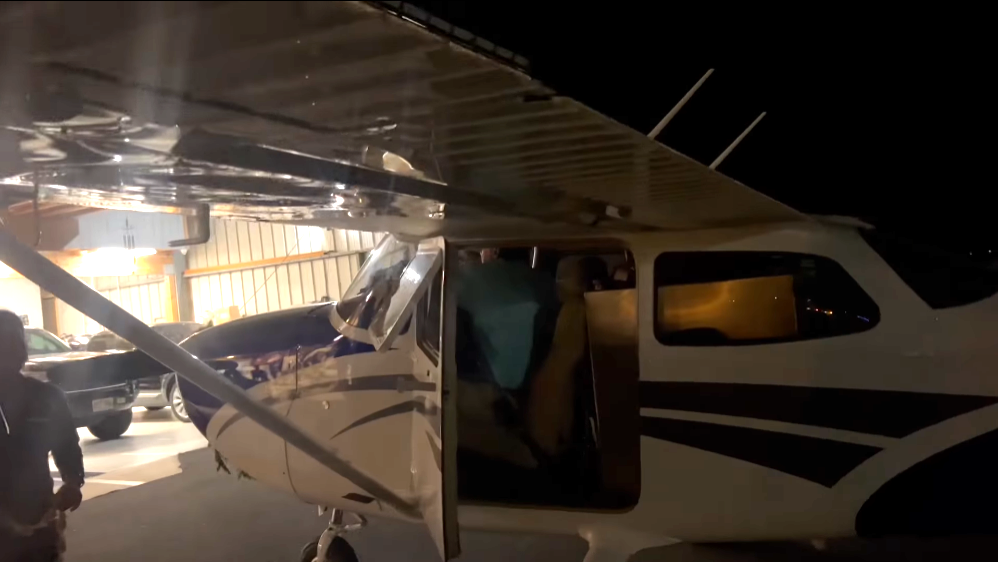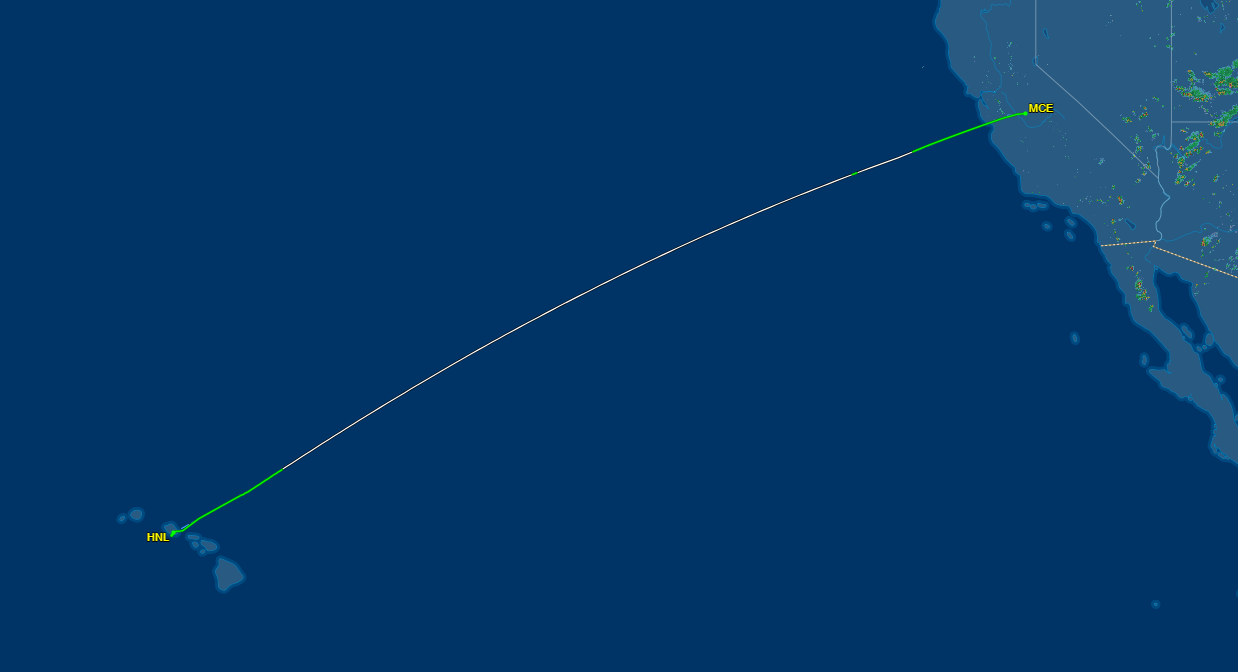On August 20, Tom Lopes boarded a new Cessna 172 G1000 NXi Skyhawk, registration N490NW. Then, at 6:10 AM Pacific Time he departed Merced Regional Airport/Macready Field in Merced, California and flew the little aircraft west. A full 18 hours, five minutes and about 2,190 nautical miles (2,521 miles) later he landed at Daniel K. Inouye International Airport in Honolulu, Hawaii. Lopes delivered the aircraft to its owner, George Hanzawa of George’s Aviation. There, the Cessna is now a part of an operation providing a flight school, tours, rentals, and more. Lopes’ long journey went viral after people online noticed the Cessna’s planned flight path on flight tracking site Flight Aware. Lopes achieved cruising speeds between roughly 113 and 130 knots (about 130 to 150 mph) and flew between 6,000 and 10,000 feet during the flight. Speeds were reportedly helped with a tailwind adding about 5 knots of ground speed.
— Kelly Lepley ✈????????✈️✈️???????????????????? (@kclepley) August 26, 2022 First flown in 1955 and still on sale today, the Cessna 172 Skyhawk has the distinction of being the most popular single-engine aircraft on the planet. These planes are easy to fly with slow landing speeds and forgiving handling characteristics. You can find 172s in the hands of private owners or making up the backbones of flight schools all over. All of my own flight hours are from behind the controls of one built in the 1970s. But one thing that a standard 172 doesn’t have is the range for a flight like this. A 172 Skyhawk like the one Lopes flew has up to 53 gallons of usable fuel. The 180 HP Lycoming IO-360-L2A under the cowling will burn that fuel in about 638 nautical miles (734 miles) when cruising at 45 percent power at 10,000 feet. This left some scratching their heads over how Lopes managed to do more than triple the distance without ending up in the Pacific. The answer comes from an interview that Lopes did with aviation YouTuber Juan Browne.
Lopes is a ferry pilot. He’s the kind of person that you call when you need your plane delivered from one destination to another. Lopes has been doing it since 1988, and says that this isn’t even the first time that he’s taken a small plane nonstop over similar distances. Thus, he was a little surprised when his routine job spread around the net.
Lopes’ flight was possible thanks the addition of a fuel tank that gave the aircraft a total of about 210 gallons of fuel. The tank was placed where the rear seat would be and it fills up the cabin. In Hanzawa’s video of the plane’s arrival you could see the tank. It basically takes up any room that Lopes wasn’t using for himself.
And since that big box of fuel impacts the aircraft’s center of gravity, he reportedly couldn’t move it out of the way to give himself a little more seat recline.
Browne explains in his video that there are two ways to get that fuel to the engine. One way would be to plumb the tank to feed the engine directly. Or, the tank could be plumbed to pump fuel into the plane’s existing fuel system. Lopes chose that route, and it appears that the extra tank feeds fuel through a line that goes into the wing root, out through a fairing, and into the wing tank through the tank’s drain.
Planning this took a ton of time, Browne explains. Lopes took three weeks to rig the extra tank. And the fuel system modifications had to get a one-time approval for the flight. It then took more weeks of just waiting for the winds to work in the flight’s favor.
From there, Lopes just had to fly the flight. But it wasn’t as simple as pointing it in the direction of Hawaii then sending it.
Every hour he had to report his position to air traffic control. At that same time he also checked his fuel levels to ensure there’s enough left to complete the flight. In addition to that, he also had to work with his team on the ground to calculate the correct power setting for his fuel burn. As Browne notes, the aircraft flew at 100 percent power for a number of hours before Lopes burned off enough fuel and began pulling back the power.
In other aircraft, Lopes might also have to use a system to top up the engine’s oil. That wasn’t required here as the new engine wasn’t expected to consume a lot of oil. And remember, he’s by himself, so that’s a long 18 hours by himself with that workload.
As for using the bathroom? Well, it’s about as your imagination expected. There are bottles for urination and should things go south, there’s a bucket! Though, considering the cramped space I’m not sure how Lopes would have pulled that off.
Of course, one question is why do this and not have the plane shipped? As Browne explains, operators would rather have someone fly the plane rather than deal with taking the plane apart for shipping then putting it back together again. As AV Buyer magazine writes, the industry for ferry flights was created in part because of how long it took to ship a plane someplace. Taking apart the plane, loading it on a ship, then putting it back together took as long as weeks, not accounting for any damage that may have occurred during shipping. But a plane could be flown to its destination far faster.
In the end, Lopes successfully delivered the aircraft with 25 gallons of fuel to spare. Hanzawa’s company then removed the ferry tank, installed the rear seat, and had a student flying less than 24 hours later. And Lopes didn’t wait long before his next ferry flight. The next weekend, he flew a Cessna 208 Caravan across the Pacific to Thailand.
Hat tip to Nathan B!
I’m not taking anything with a single engine 1000+ miles from the nearest land.
It isn’t said how much our pilot here was paid, but I hope it was some decent change!
The History Guy on yt has a short video about him. A good chuckle and a real piece of Americana well worth 10ish min of your life
[I promise I won’t spam this on any more Aerotopian articles for a year or so]
Also, just looking at the photo of the pilot’s seat is aggravating my claustrophobia. Even if I could physically tolerate sitting in that seat for hours, there is no way I could handle it mentally.
https://www.sportys.com/little-john-pilot-urinal.html
But even without an autopilot once an airplane is trimmed for level flight it is pretty stable, so you can take your hands off the yoke for a bit and be fine.
I hope the man was well compensated for that trip. He deserves something like hazard pay on top of his standard fee.
I don’t know much about general aviation flight planning, so I’m comparing it to what’s done in the commercial realm, and I can’t stop thinking about ETOPS (originally: Extended Twinjet Operations, later simply: Extended Operations, or comically: Engines Turn or Passengers Swim). ETOPS rules require routes to be selected that allow for the aircraft to divert to a suitable airport to land in the event of an in-flight emergency. The diversion requirements are defined by time aloft (e.g., planning a route such that you’re never more than, say, 60 or 90 minutes away from a suitable airport), and the times have steadily increased over the years with improvements in engine reliability (though a rigorous maintenance schedule must be kept up to keep commercial airplanes “ETOPS qualified”). The Cessna 172, of course, has only one engine, so it makes me wonder what flight planning was involved in the event of an emergency. It looks like he took a straight shot over, and that’s a LOT of lonely open water!
following web »> https://googleworksoffer96.blogspot.com/
Except here, doesn’t seem to be organized crime putting lead bars in the seats to increase the weight and throw off the pilot’s fuel range calculations…
I remember the end of the OG as kid, but being an extra on the new one was fun when I lived in Hawaii. Perdita Weeks and Stephen Hill are as nice human beings as you can imagine. The cast and crew are all just….nice.
Which, sadly, is more than I can say for other performers and casts of other productions I was on set for.
Anyway, these types of planes can be more cost efficient to island hop, if you pack light (and are not prone to air sickness.) They also are great for photographers, pro or hobbyist (like my wife). They are slower, and you can actually see stuff. Like breaching whales. We went to Maui and Molokai for vacations this way when we lived on Oahu. It cost us a little less the same as a ticket on Hawaiian, and we were more limited in your luggage weight, but the luggage is not an extra fee. And some of them have shuttles that pick you up at your house, so you don’t have to deal with HNL parking fees. We felt it was worth it. The views alone justified the slower flight.
Perhaps the owner of this plane intends to use it for that purpose, and the cost of transport is a write off as a business expense?
Looks like the buyer does sightseeing trips, charters, rentals, and “learn to fly” training sessions. This plane in particular looks like it’s on their “available to rent” website.
If I remember right these are designed to have the wings/tail removed. Better than I mis-judged the fuel or the engine goes NOPE!




